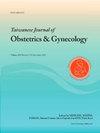Obstetric and neonatal outcomes in pregnant women with left-sided valvular stenosis in a tertiary medical center in Taiwan
IF 2.2
4区 医学
Q2 OBSTETRICS & GYNECOLOGY
引用次数: 0
Abstract
Objective
Left-sided valvular stenosis increases pregnancy-associated risks. We aim to compare maternal and neonatal outcomes between women with left-sided valvular stenosis and controls and to determine the predictors of adverse pregnancy outcomes.
Materials and methods
We retrospectively retrieved data in the Chang Gung Research Database from women who had at least one prenatal examination record or pregnancy-related diagnosis code and gave birth, terminated the pregnancy, or took abortion pills in the hospital and had confirmed aortic stenosis or mitral stenosis based on echocardiographic reports, surgical reports, and discharge summaries. Propensity score matching (PSM) was used to balance covariates between the left-sided valvular stenosis and control groups.
Results
Patients in the left-sided valvular stenosis group were of shorter height, lower weight and body mass index, and had a higher rate of atrial fibrillation compared to controls. After PSM, the left-sided valvular stenosis group (n = 52) had more heart failure, chronic kidney disease, and use of digoxin and anticoagulants than did the control group (n = 260). Pregnancy outcomes in the left-sided valvular stenosis group included a higher cesarean section rate, lower gestational age, and a higher rate of newborn intensive care unit transfer than controls. The composite adverse maternal event rate did not differ significantly between the two groups, but the composite adverse neonatal event rate (premature birth, low birth weight) was higher in the left-sided valvular stenosis group. Regional anesthesia was most commonly used during cesarean section in both groups. Left-sided valvular stenosis, heart failure, general anesthesia, and cesarean section were significant factors associated with increased risks of composite adverse neonatal events.
Conclusions
Among pregnant women, those with left-sided valvular stenosis had more comorbidities and medication use during pregnancy and were more likely to give birth to premature babies with low birth weight and poor vitality.
台湾某三级医疗中心左侧瓣膜狭窄孕妇的产科及新生儿结局
目的左侧瓣膜狭窄增加妊娠相关风险。我们的目的是比较左侧瓣膜狭窄妇女和对照组的产妇和新生儿结局,并确定不良妊娠结局的预测因素。材料和方法回顾性检索常工研究数据库中至少有一项产前检查记录或妊娠相关诊断代码,在医院分娩、终止妊娠或服用流产药物,并根据超声心动图报告、手术报告和出院总结确诊主动脉瓣狭窄或二尖瓣狭窄的妇女的资料。倾向评分匹配(PSM)用于平衡左侧瓣膜狭窄组和对照组之间的协变量。结果左侧瓣膜狭窄组患者身高较矮,体重和体质指数较低,房颤发生率高于对照组。PSM后,左侧瓣膜狭窄组(n = 52)比对照组(n = 260)有更多的心力衰竭、慢性肾脏疾病、地高辛和抗凝剂的使用。与对照组相比,左侧瓣膜狭窄组的妊娠结局包括更高的剖宫产率、更低的胎龄和更高的新生儿重症监护病房转移率。两组产妇综合不良事件发生率无显著差异,但左侧瓣膜狭窄组新生儿综合不良事件发生率(早产、低出生体重)较高。两组剖宫产术均以区域麻醉为主。左侧瓣膜狭窄、心力衰竭、全身麻醉和剖宫产术是增加新生儿复合不良事件风险的重要因素。结论左侧瓣膜狭窄孕妇在妊娠期合并症和用药较多,生下低出生体重、活力差的早产儿的可能性较大。
本文章由计算机程序翻译,如有差异,请以英文原文为准。
求助全文
约1分钟内获得全文
求助全文
来源期刊

Taiwanese Journal of Obstetrics & Gynecology
OBSTETRICS & GYNECOLOGY-
CiteScore
3.60
自引率
23.80%
发文量
207
审稿时长
4-8 weeks
期刊介绍:
Taiwanese Journal of Obstetrics and Gynecology is a peer-reviewed journal and open access publishing editorials, reviews, original articles, short communications, case reports, research letters, correspondence and letters to the editor in the field of obstetrics and gynecology.
The aims of the journal are to:
1.Publish cutting-edge, innovative and topical research that addresses screening, diagnosis, management and care in women''s health
2.Deliver evidence-based information
3.Promote the sharing of clinical experience
4.Address women-related health promotion
The journal provides comprehensive coverage of topics in obstetrics & gynecology and women''s health including maternal-fetal medicine, reproductive endocrinology/infertility, and gynecologic oncology. Taiwan Association of Obstetrics and Gynecology.
 求助内容:
求助内容: 应助结果提醒方式:
应助结果提醒方式:


